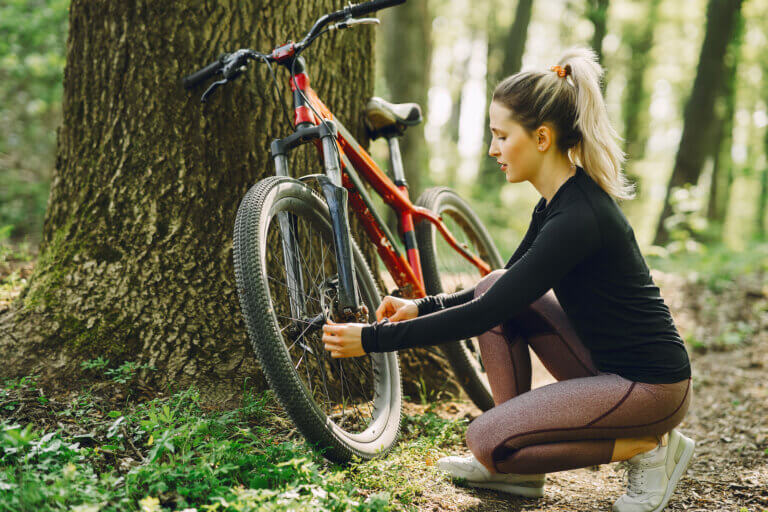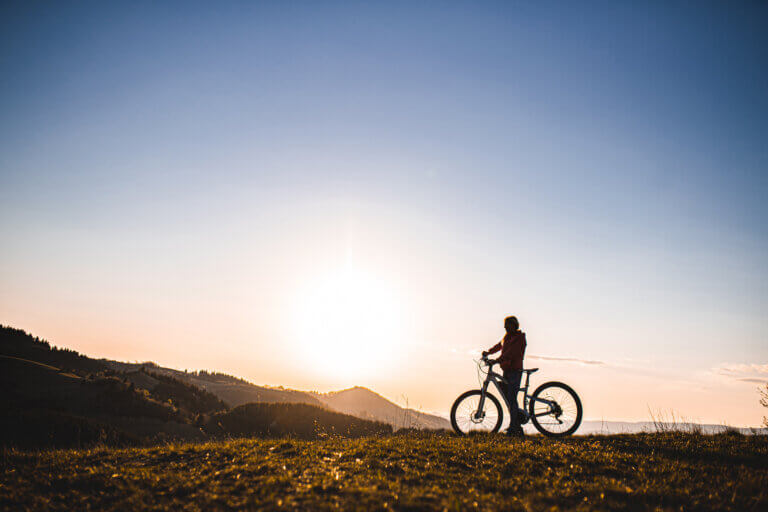COVID-19 has caused a surge in bicycle sales and repairs as more and more cyclists hit the trails. Here’s how to stay safe and share the mountain with your fellow cyclists.

Since March of 2019 when the pandemic hit, the United States has seen an incredible increase in bicycle sales. Bike shops and manufacturers are consistently sold out of inventory and they’re having trouble keeping up with demand.
Not only are sales booming, but repair services are surging as well — people who used to ride are rediscovering their love of cycling. The cobwebs are coming off and the trails are filling up.
Plus, new cyclists are hitting the trails every single day. And while the cycling community welcomes everyone with open arms, more traffic leads to more incidents — especially with newbies in the seat. Check out these tips to learn how to ride and share trails with the best of them.
What’s in this article:
Bike Trail Etiquette 101
You’ve got the gear, the new ride, and you’re ready to conquer the mountain — but first, it’s important to familiarize yourself with common bicycling etiquette to protect yourself, and the other cyclists.
Mountain trails can be particularly narrow which means if you aren’t careful, accidents can happen. Cyclists certainly aren’t strangers to injury and even fatality so use the tips below to minimize risk for everyone out there.
Pay attention to bicycle trail signs
Most bicycle trails have markers for cyclists before they get started. You’ll notice maps, rules of the trail, and tips on what to do in case of emergency (like call the local land or park manager). You’ll also notice markers along the trail itself once you get started.
These signs are important because they’ll give you a heads up on things like:
- Dangerous animals or plants
- Rules of the trail like one-way traffic only
- Where to dispose of litter
- Park and trail hours
- Speed limits
Trail rules likely differ from park to park so be sure to stay alert and keep your eyes open for these signs and markers. Things like speeding or ignoring one-way traffic signs can lead to serious injury, liability lawsuits, and more.
Follow the trails to preserve them
It’s tempting to cross over switchbacks and save time or just try something new — but by not sticking to the trails, you put the natural wildlife (and the trail itself) at risk. Crossing over a switchback, especially when it’s soft, can erode the trail. This makes it harder for other cyclists to ride and could lead to trail closure. Plus, it can disrupt plant life that grows between each switchback.
The same applies to straightaway sections of the trail. When you go off the path, you risk getting caught by a park ranger at best. At worst, you risk running into dangerous animals or plants, injury, and irreparable landscape damage. In short, cyclists who consistently go off the path can ruin the trail for everyone because they risk having the trail shut down.
Know when to yield to other cyclists and trail visitors
Trails are shared by cyclists and pedestrians alike. If you ride a mountain path, you’re likely to encounter many twists and turns — which means you won’t be able to see around each corner. Mitigate risk for everyone by knowing when to yield the right of way and exercising caution.
- Use verbal cues or bells to alert other trail-goers (e.g. “on your left”)
- Follow one-way and downhill-only rules
- Always give way to pedestrians and horses, even if the path is for cyclists only
- Cyclists going uphill have the right of way
- Keep interactions with other trail-goers friendly
- Look up leash laws ahead of time if your dog is riding with you
Remember that every bike trail is different and the rules of the path can vary. Check the path’s signs and markers to get a feel for when (and how) to yield to fellow cyclists and pedestrians. If you aren’t sure what to do, stay alert, use caution, and follow the guidelines above unless they conflict with the rules of the park you’re in.

Cyclist Liability & Bicycle Insurance Coverage
Now that we’re familiar with the rules of the trail, let’s discuss liability. If something goes wrong and you or another person is injured, it’s important to know who is responsible. This can not only prevent you from causing damage, but it’ll also come in handy when it’s time to talk with your bicycle insurance company. Here are a few examples of common issues cyclists face on the trails including who is liable, and what’d be covered under insurance.
Bike Trail Scenario #1
You ride uphill and a downhill rider crashes into you
Who is responsible
In general, the downhill rider must yield to the uphill rider on a two-way trail. If the downhill rider fails to yield and crashes into you, they’d most likely be liable. However, if you ride uphill on a downhill-only trail, you could be partially or completely responsible for the crash.
What’s covered
If you aren’t liable for the crash, your Simple Bike Insurance policy will cover 100% of your bike’s damage. If your bicycle is totaled, your policy should cover the full-value of your bike (which is up to you when you insure it). Additionally, if you included medical coverage as a part of your policy, your hospital bills will be covered up to $1,000.
If you are liable for the crash and added liability insurance, your Simple Bike Insurance policy covers you up to $25,000. If you don’t have the liability add-on, you risk paying for the damage out of pocket.
Bike Trail Scenario #2
You ride downhill and botch a jump
Who is responsible
This is a tough gray area and largely depends on the incident’s details. For example, did you botch a jump because another rider forced you off the trail? If so, the other rider may be liable — especially if they were speeding and/or not yielding appropriately.
Or, did you botch the jump to avoid crashing into an uphill rider? In this case, you may have been speeding and not yielding the right of way to the uphill rider — which would make you liable for the incident.
What’s covered
Your Simple Bike Insurance policy covers up to $25,000 in liability costs and $1,000 in medical costs if you chose to include the add-ons in your policy. This covers you in case you’re involved in an incident where liability isn’t clear, or if you’re at fault for the accident.
Bike Trail Scenario #3
You crash into a pedestrian
Who is responsible
Unless the pedestrian willfully throws themselves in front of your bicycle, you’re probably liable for the crash and damage. In most cases, cyclists must yield to all other pedestrians and horseback riders on the trail. If you accidentally crash into one, you’re likely at fault.
What’s covered
If you opted for the liability option when you purchased your Simple Bike Insurance policy, you’re covered up to $25,000 in liability. This means we’ll pay for the pedestrian’s health costs and property damage up to that amount — so you don’t have to pay for it out of pocket.
How is bicycle insurance different from homeowner’s insurance or renter’s insurance?
This is a common question asked by many new and advanced cyclists. Although your other insurance policies may offer some coverage in case something goes wrong, they aren’t going to cover things like crashes and collisions out on the trails.
Simply put, renter’s and homeowner’s insurance aren’t going to pay for costs you incur due to:
- Crashes
- Collisions
- Liability
- Travel damage
- Theft on the trail
With policies starting at just $100 a year and affordable add-ons for full coverage, Simple Bike Insurance gets you riding with greater peace of mind. We’re your spokespeople when things don’t go as planned. Plus, wouldn’t it be nice to ride without worrying about your finances?
